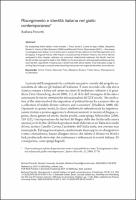Chapter Risorgimento e identità italiana nel giallo contemporaneo
| dc.contributor.author | Pezzotti, Barbara | |
| dc.date.accessioned | 2022-09-15T20:08:22Z | |
| dc.date.available | 2022-09-15T20:08:22Z | |
| dc.date.issued | 2022 | |
| dc.identifier | ONIX_20220915_9788855185974_126 | |
| dc.identifier.issn | 2420-8361 | |
| dc.identifier.uri | https://library.oapen.org/handle/20.500.12657/58330 | |
| dc.language | Italian | |
| dc.relation.ispartofseries | Biblioteca di Studi di Filologia Moderna | |
| dc.subject.classification | thema EDItEUR::D Biography, Literature and Literary studies | en_US |
| dc.subject.other | Crime Fiction | |
| dc.subject.other | Marcello Fois | |
| dc.subject.other | Massimo Siviero | |
| dc.subject.other | Pietro Soria | |
| dc.subject.other | Risorgimento in Literature | |
| dc.title | Chapter Risorgimento e identità italiana nel giallo contemporaneo | |
| dc.type | chapter | |
| oapen.abstract.otherlanguage | By analysing three Italian crime novels – Piero Soria’s Cuore di lupo (1999), Massimo Siviero’s Il terno di San Gennaro (1999) and Marcello Fois’s Dura madre (2001), – this essay investigates how Italian crime fiction set in present times reflects on the Risorgimento and its legacy. It argues that by referring to a crucial period of Italian history, the crime stories analysed in this chapter address an unsolved relationship between the North and the South of Italy brought to light in the 1990s by the success of controversial political parties such as the Lega Nord. In particular, I show how with Dura madre, Fois indicates a way of uniting Italy through a mutual understanding that preserves regional identities and cultures. | |
| oapen.identifier.doi | 10.36253/978-88-5518-597-4.04 | |
| oapen.relation.isPublishedBy | bf65d21a-78e5-4ba2-983a-dbfa90962870 | |
| oapen.relation.isbn | 9788855185974 | |
| oapen.series.number | 66 | |
| oapen.pages | 12 | |
| oapen.place.publication | Florence |

